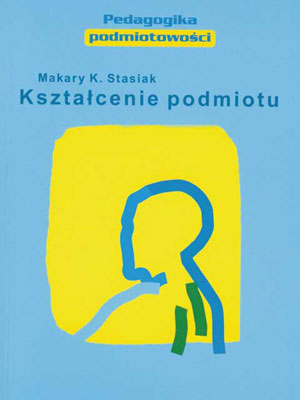Conferences:

The book that the Reader now holds in their hands is not an easy read. I make this remark not to discourage the Reader from the toil of studying the text, but to prepare and help them to wade through the book. The difficulty of the text resides in its content. Kształcenie podmiotu (Subject-directed Education) is a book written in colloquial language. Thus, in order to truly understand the work, it is not enough to read it and familiarize oneself with its contents. The Reader should also master and practice the described structure. This is not an easy task. Usually, reading a book results only in enriching an already possessed knowledge. In this work, I have described a new structure of thinking and conducting research. In order to explain its innovative character, I shall present an analogy.
A computer is equipped with a few basic programs which enable its usage. Usually, the work with a computer consists in mastering the needed program, for instance the program which facilitates the writing process, namely Word. We understand broadening our knowledge as following consecutive, earlier unknown instructions within the framework of Word ? the program we already know. Sometimes, however, we are faced with a more difficult situation. This may happen when we want to master a new program, for example Excel. Gaining knowledge consists then not in learning new instructions within the framework of the already known program, but in mastering a totally new program. Learning a new program is more difficult than familiarizing oneself more thoroughly with the program one already uses. Still, it will prove to be worth the trouble. The new program facilitates the application of new activities. Excel, for instance, is useful in making calculations, creating tables, etc.
An analogous situation occurs in this work. The book contains a description of a new program. It presents a different way of using our mind. Until recent times, we used the possibilities of our mind within the framework of the program commonly called scientism. This is an excellent program, and yet nowadays human beings want to achieve much more, and so the ancient scientistic concept proves insufficient. Furthermore, people have become more demanding. They have enriched their intellectual capabilities and arrived at a higher level of disposition, a new way of using their mind. Thanks to the founders of phenomenology and hermeneutics, the human being has enriched their ability to think in the category of understanding. People have begun to realize that they imbue their reality with meaning, that they understand reality in a certain way. Subsequent to the new understanding of a given aspect of reality, a chance for its fuller use and practical realisation arises. Developing a new understanding of the same fragment of reality broadens the possibilities of its usage with activities resulting from the new understanding. This means that human beings have become conscious of their theoretical and practical way of referring to reality.
All that has recently taken place in the sphere of human possibilities can be described by means of a different computer analogy. The consciousness of the theoretical and practical ways that human beings refer to reality cannot be compared to a transition from one program to another, but rather it is similar to mastering the skill of writing computer programs consciously and independently. In the past, it took centuries to create such programs and the process was somewhat unintentional. The development of a program which defined the way people referred to reality, such as ?the Renaissance? or ?positivism?, lasted many years, while the precursors of these trends did not fully realize that they were forming a new style, a new attitude towards the reality. Another disadvantage of the earlier method was the common rejection of the previous program and the common acceptance of the new one. This meant that, at any given point of history, people used only one ? the most recent ? program. Today, due to being conscious of their activity, people can write new programs and use all of them depending on their needs. This means that human beings can simultaneously use many programs as well as change and adjust them to the kinds of problems they face. Encountering a problem, one should use the program which is most suitable.
This book is also difficult because a new level of thinking was used in writing it. This new thinking has been used to describe the classical academic method of scientism, since one cannot describe a new way of thinking without showing its practical application.
The main sources of inspiration for the concept of subject-directed education are the achievements and works of the author of this publication as well as the theories and thoughts taken from the dynamically developing international trend in academic research in the field of creativity and creative problem solving.